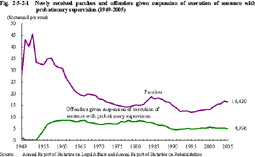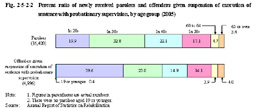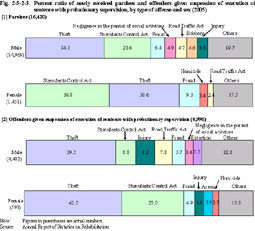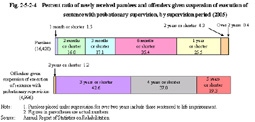| Previous Next Index Image Index Year Selection | |
|
|
1 Probationers and parolees under supervision (1) Number of probationers and parolees Fig. 2-5-2-1 shows the trends in the numbers of parolees (prison parolees; hereafter the same in this chapter) and offenders given suspension of execution of sentence with probationary supervision newly received by probation offices since 1949.
The number of parolees had been on an upward trend since 1996, but decreased slightly in 2005. The number of offenders given suspension of execution of sentence with probationary supervision has been decreasing since 2001. Fig. 2-5-2-1 Newly received parolees and offenders given suspension of execution of sentence with probationary supervision (1949-2005) As of December 31, 2005, the number of parolees was 7,715 (down by 4.7% from the previous year), and the number of offenders given suspension of execution of sentence with probationary supervision was 15,413 (down by 1.7% (id.)) (Source: Annual Report of Statistics on Rehabilitation).(2) Characteristics of probationers and parolees a. Age Fig. 2-5-2-2 shows the percent ratio of parolees and offenders given suspension of execution of sentence with probationary supervision newly received in 2005, by age group.
Fig. 2-5-2-2 Percent ratio of newly received parolees and offenders given suspension of execution of sentence with probationary supervision, by age group (2005) b. Type of offense Fig. 2-5-2-3 shows the percent ratio of parolees and offenders given suspension of execution of sentence with probationary supervision newly received in 2005, by type of offense and sex.
The percent ratio was high for theft and Stimulants Control Act violations among both sexes as well as both parolees and offenders given suspension of execution of sentence with probationary supervision. Fig. 2-5-2-3 Percent ratio of newly received parolees and offenders given suspension of execution of sentence with probationary supervision, by type of offense and sex (2005) c. Supervision period Fig. 2-5-2-4 shows the percent ratio of newly accepted parolees and offenders given suspension of execution of sentence with probationary supervision by supervision period in 2005.
Supervision periods for most of the offenders given suspension of execution of sentence with probationary supervision were over two years, while those for parolees were much shorter and were six months or shorter for more than two-thirds of them. Fig. 2-5-2-4 Percent ratio of newly received parolees and offenders given suspension of execution of sentence with probationary supervision, by supervision period (2005) d. Residential situation Fig. 2-5-2-5 shows the percent ratio of parolees and offenders given suspension of execution of sentence with probationary supervision newly received in 2005, by residential situation.
The percent ratio of those living in halfway houses was highest among parolees, while the largest proportion of offenders given suspension of execution of sentence with probationary supervision lived with parents. Fig. 2-5-2-5 Percent ratio of newly received parolees and offenders given suspension of execution of sentence with probationary supervision, by residential situation (2005) |




